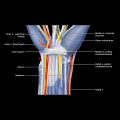Joint Effusion
ESSENTIAL INFORMATION
Key Differential Diagnosis Issues
Helpful Clues for Common Diagnoses
 Most commonly affects knee, hip, interphalangeal, 1st carpometacarpal, triscaphe, wrist, acromioclavicular, and tarsal joints
Most commonly affects knee, hip, interphalangeal, 1st carpometacarpal, triscaphe, wrist, acromioclavicular, and tarsal joints
 Joint space narrowing, marginal osteophytosis, capsular swelling, synovitis, and effusion are US signs of OA
Joint space narrowing, marginal osteophytosis, capsular swelling, synovitis, and effusion are US signs of OA
 Variable increase in joint fluid
Variable increase in joint fluid
 Variable degree of reactive-type inflammatory synovial proliferation
Variable degree of reactive-type inflammatory synovial proliferation
 ± variable periarticular inflammation
± variable periarticular inflammation
 US is increasingly used to determine inflammatory component of OA and differentiate OA from crystal deposition disease or inflammatory arthropathy
US is increasingly used to determine inflammatory component of OA and differentiate OA from crystal deposition disease or inflammatory arthropathy
 Inflammatory element of OA is characterized by
Inflammatory element of OA is characterized by
Helpful Clues for Less Common Diagnoses
 Affects any synovial-lined joint
Affects any synovial-lined joint
 Ranges from single (monoarthropathy) to few (oligoarthropathy) to multiple (polyarthropathy) joint involvement
Ranges from single (monoarthropathy) to few (oligoarthropathy) to multiple (polyarthropathy) joint involvement
 Most common finding: Pannus
Most common finding: Pannus
 Effusion may be anechoic or hyperechoic
Effusion may be anechoic or hyperechoic
 ± echogenic speckles due to precipitated fibrin or inflammatory debris
± echogenic speckles due to precipitated fibrin or inflammatory debris
 ± marginal erosions
± marginal erosions
 Color Doppler imaging
Color Doppler imaging
 Other signs include joint space narrowing, subluxation, deformity, and ankylosis
Other signs include joint space narrowing, subluxation, deformity, and ankylosis
 Coexistent soft tissue features include tenosynovitis, bursitis, and entrapment neuropathy
Coexistent soft tissue features include tenosynovitis, bursitis, and entrapment neuropathy
 Always consider in any acute arthritis
Always consider in any acute arthritis
 Effusion can be anechoic or hyperechoic
Effusion can be anechoic or hyperechoic
 Gout results from urate crystal deposition
Gout results from urate crystal deposition
![]()
Stay updated, free articles. Join our Telegram channel

Full access? Get Clinical Tree








